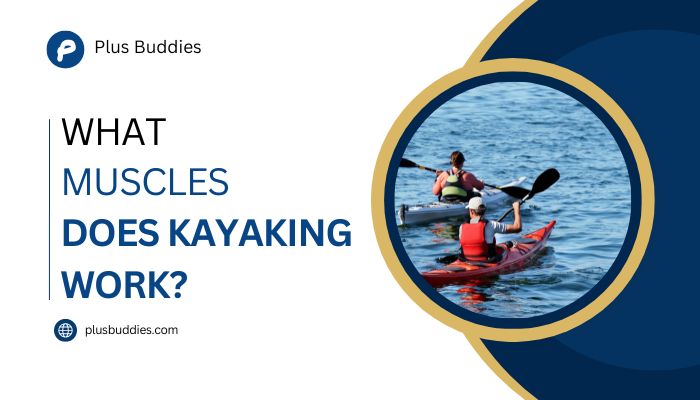Kayaking engages various muscle groups, offering a full-body workout that strengthens and tones key areas. What muscles does kayaking work? From the powerful strokes of the paddle to maintaining stability and balance, this water sport activates muscles across the arms, shoulders, core, and back.
Kayaking isn’t just an exciting water sport but a fantastic full-body workout that engages multiple muscle groups. The vigorous paddling primarily targets the upper body, especially the arms, shoulders, and back muscles. As you propel the paddle through the water, the deltoids, triceps, and chest muscles exert force, building strength and endurance.
By effectively engaging multiple muscle groups, kayaking serves as a dynamic workout that offers a thrilling experience on the water and helps ton, strengthen, and improve overall muscular endurance.
Discover what muscles does kayaking work and how paddling provides both a thrilling adventure and an effective exercise regimen.
What is the Proper Kayaking Form?
Proper kayaking form involves sitting upright with a straight back, knees slightly bent and pressed against the kayak, and a relaxed grip on the paddle held slightly wider than shoulder-width apart. When paddling, alternate sides, dipping the paddle near your feet and pulling it smoothly through the water to your hips, engaging your core for each stroke.
Rotate your torso with each paddle stroke, keeping your head aligned and looking straight ahead while occasionally scanning the surroundings. Maintaining stability by adjusting your body weight as needed ensures a safe and efficient kayaking experience.
What muscles does kayaking work?
Kayaking isn’t just a calorie-burning activity; it’s a holistic workout engaging multiple muscle groups. Its low-impact nature makes it accessible for individuals with joint concerns, offering a chance to enjoy this sport.
This water-based exercise actively targets a range of major muscle groups, including the abs, biceps, triceps, lats, shoulders (deltoids), thighs (quadriceps), hamstrings, glutes, and calves. The repetitive nature of kayaking enhances muscle development across the arms, back, and shoulders, contributing to overall muscular strength.
With every session, you’ll witness a noticeable improvement in muscle definition and strength, boosting calorie expenditure and aiding weight loss.
The paddling motion plays a pivotal role in engaging the back and shoulders. It requires lifting the paddle forward, transferring weight from the lats to the shoulders in a swift movement that activates the anterior, lateral, and rear deltoids. This dynamic action involves isometric muscle engagement, effectively working and strengthening these muscle groups.
Furthermore, kayaking offers a complete upper-body and core workout, which involves standing against gravity while coordinating opposing motions with both arms. This constant stabilization against waves or choppy waters challenges balance and fortifies the entire torso area, reducing the risk of tipping or capsizing.
What Muscles Does Kayaking Work In The Shoulder Area?
Kayaking is a champ when it comes to working out those shoulder muscles! It hits various parts of your shoulders, giving them a solid workout. When you paddle, you’re not just moving your arms but engaging your shoulders.
This action targets different areas like the front, sides, and rear parts of your shoulders, making them work together to power through each stroke. It’s like a full-on shoulder workout that helps build strength and tone those muscles pretty awesomely!
How does kayaking work with chest muscles?
Kayaking is a great way to target your chest muscles. When you paddle, pulling the paddle through the water engages your chest, specifically the pectoral muscles. This movement involves more than just your arms—it recruits your chest muscles to generate power and pull the paddle effectively.
As you reach forward and dip the paddle into the water, your chest muscles activate to pull it backwards, propelling you forward. This repetitive pushing and pulling motion engages your chest muscles, providing an effective workout.
Over time, this activity helps strengthen and tone your chest muscles while you navigate the waterways, giving you both a thrilling adventure and a chest-focused workout.
Health benefits of kayaking
Here are the health benefits of kayaking in bullet points:
Upper Body Workout: Engages arms, shoulders, and chest muscles.
Core Strengthening: Twisting motions activate core muscles, improving stability.
Cardiovascular Fitness: Boosts heart health and overall endurance.
Weight Management: Burns calories, aiding in weight control.
Stress Reduction: Being on the water promotes relaxation and mental well-being.
Improved Flexibility: Enhances flexibility, especially in the upper body.
Low-Impact Exercise: Gentle on joints while providing a full-body workout.
Connection with Nature: Offers a chance to connect with the outdoors for mental clarity.
Enhanced Balance and Coordination: Improves balance and coordination skills.
Social Engagement: This can be a social activity, fostering connections with others.
Conclusion: What Muscles Does Kayaking Work?
Kayaking isn’t your average workout—it’s an adventure disguised as a fitness routine. It’s like sculpting muscles while cruising through nature’s gym. But it’s not just about the physical gains; with every paddle stroke, there’s a symphony of tranquillity, a rhythm that syncs with the waters.
Kayaking isn’t merely exercise; it’s the ultimate fusion of fitness, zen, and nature’s playground, all in one exhilarating ride on the waves.

Welcome, I am Jerry Harper. I provide plus-size accessories encompassing swimwear, treadmills, bathing, and shoes. and more. I specialise in crafting innovative concepts that captivate readers within the dynamic landscape of plus-size fashion trends.
